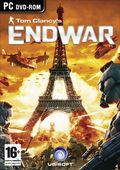You can trust VideoGamer. Our team of gaming experts spend hours testing and reviewing the latest games, to ensure you're reading the most comprehensive guide possible. Rest assured, all imagery and advice is unique and original. Check out how we test and review games here
“Okay men, listen up! Our orders have come through from the general. He says that we must go to Beta.”
“I don’t understand, Sarge. There isn’t any ‘Beta’ on our map! What does he mean?”
“I have no idea, soldier. I asked him to clarify, but he kept shouting, ‘GO TO BETA! GO TO BETA! He was getting pretty miffed, so I just pretended I understood.”
“Maybe he was talking about his wife? He might have been saying, ‘Go to beat her?'”
“Yeah, that’s probably right! Lock and load, men! The general is about to become single again…”
It’s probably worth mentioning right now that when you’re playing Tom Clancy’s Endwar, it’s quite important that you remember your phonetic alphabet. At one point during our recent hands-on with the multiplayer side of the voice-controlled RTS, we managed to draw a blank and completely forget that B is actually Bravo. As a result, we spent a good minute or so yelling complete gibberish at our troops – until we suddenly remembered Andy McNab’s bestseller, ‘Bravo Two Zero.’ Having been correctly ordered, our soldiers finally yomped off to achieve their objective; thankfully this mistake didn’t cost us the battle.
The point is this: if you’re having trouble commanding your battalions during the course of an Endwar match, it’s far more likely to be your fault than the game’s. Cast aside those unhappy memories of Dr Kawashima’s Brain Training, where you were forced to scream ‘BLUE!’ until your face turned that very same colour. Here, once you get used to the structure of issuing orders, you’ll find that your troops are more than happy to oblige your every whim. All you do is hold down the right trigger, say your piece, and release. Most commands start with you identifying a unit, adding a verb and then finally a subject. Common examples would be “Unit 2 attack hostile 3,” or “Unit 3 secure Delta.” You can also use the word “plus” to select multiple forces or to create groups, and switch your perspective on the battle by saying “camera” followed by the unit you wish to see. Your command vehicle will give you access to an overhead satellite view of the action, but for the most part the camera will be positioned next to one of your troops. You’ll see what they see, a touch which considerably increases the intensity of battles.
On any given map, each side will have a set of objectives based around defending or assaulting the area – but there’s pretty much always an emphasis on capturing and securing control points. These buildings, identified by phonetic call-signs, are your one and only resource. Sending an infantry team to capture these spots will boost your reinforcement allowance, which in turn means that you can summon fresh blood to the battle. At the start of a skirmish you’ll only have access to two or three unit slots, but as the fight progresses you’ll eventually have access to up to 12 – allowing for a mix of tanks, helicopters, artillery, transports and infantry. Everything has the same resource cost and everything has a strength and weakness – so in typical RTS fashion, you’ll need a balanced army to succeed. The experience mechanic adds an additional edge to proceedings: any unit that survives a battle can be upgraded at your barracks, so you may end up getting quite protective of soldiers or vehicles who perform well. In a nice touch, defeated forces aren’t automatically killed but are rather left stranded until they’re collected by a rescue chopper. Ubisoft tells us that some test players have taken to shooting down their enemies as they evacuate – a move which tends to heighten the enmity between opposing generals.
While we’re on the subject of the horrors of war, we should mention the impact of weapons of mass destruction. During the main part of a battle WMDS are strictly off limits, but as soon as one side fulfils their mission requirements, a victory countdown starts. At this point the losing general is free to unleash their missile supply in a last-ditch attempt to save the day – but in accordance with the age-old principle of Mutually Assured Destruction, doing this will also permit return fire. If you’re close to defeat, it’ll be up to you to decide how dirty the battle will get. Should you go all-out for the win, or spare the likelihood of your veteran grunts getting blown to Kingdom Come?
Aside from WMDs, other tactical options like airstrikes can be gained by upgrading control points. Of course, everything will cost you resources – and in this game, you really have to think before you spend. Units feel far more valuable than in most other RTSs. In our first multiplayer match our opponent threw too many vehicles into an area we were tightly controlling, and as a result his army was low on reinforcements when we staged a counter attack. On the other hand, the following skirmish saw us totally outplayed by Ubisoft’s PR Agent: he cunningly spread the battle onto multiple fronts, tricking us into splitting our legion into several disparate groups. There’s no doubt that learning the strategy of Endwar will take some time, but with the streamlined resource collection in place we imagine most people will enjoy the pronounced emphasis on combat tactics.
As you may be aware, Endwar’s multiplayer Theatre of War mode will essentially offer an extended campaign that is shaped by the efforts of gamers all over the world. When you log in, you’ll be presented with a world map divvied up into 40 territories, in the style of the classic board game Risk. Each one will feature a battle between two of the three playable superpowers – the US, Russia and Europe – with one side attacking and the other defending. At the end of a set period of time, Endwar will declare that “turn” of the game to be over, and will calculate the outcome for each territory, based on the battles fought there: If Russia defeated Europe in 68 per cent of the Paris matches, then they’ll take control of that region. As an individual player you’ll be using the same army which you’ll improve and upgrade as you gain experience – but the landscape of the game will be constantly changing. World War 3 will continue even while you’re not playing, until a campaign is eventually completed and a new one starts. Ubisoft Shanghai reckon that each war will last roughly three weeks, and as things progress they’ll have the option to create new events based around what’s been going on. If the Yanks get a bit too powerful, for example, the developers might stage a D-Day attack on US soil in an attempt to level things out. Sounds pretty cool to us.
It would have been easy for Endwar to have been a gimmicky one-trick pony, but having put our larinxes (Larinxi? Larines?!) to the test, we’re happy to report that this is not the case. The strategic combat seems really quite demanding, so much so that you come to appreciate the speed of voice commands. The only time that vocal control became an issue was when our opponent started to overwhelm us and we started to panic – but in a perverse way, this actually adds to the sense of realism: after all, how many generals got to the top of their game by um-ing and err-ing when the proverbial brown stuff hit the fan? No, to play Endwar you’re going to need a clear head – that and a decent memory for the phonetic alphabet. Lima Oscar Lima!
Endwar will be released on PS3 and Xbox 360 on November 7 2008

/https://oimg.videogamer.com/images/1552/endwar_52.jpg)
/https://oimg.videogamer.com/images/fc7d/endwar_46.jpg)






